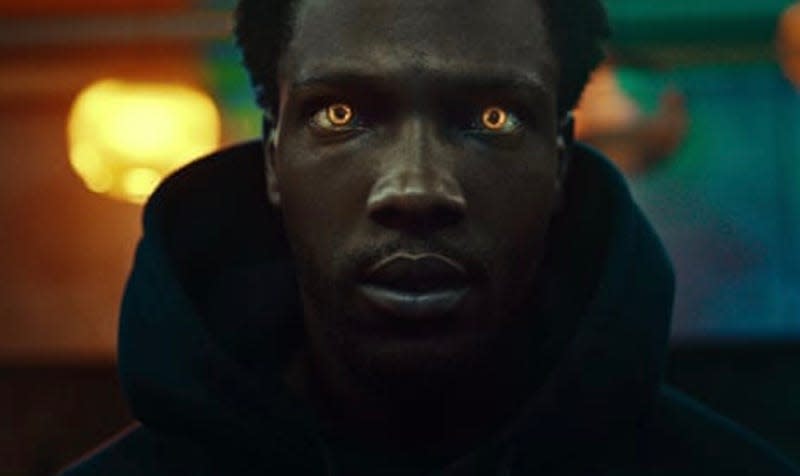Supacell Episode 1 Review: Survival And Synchronicity

Rapman’s new Netflix series Supacell envisions a reality in which multiple Londoners develop sudden superpowers, and all of them have a commonality: they’re Black. We meet the characters separately, but the short scenes reveal a great deal about the nature of each character, and by the end of the episode, we see them cross paths, at least casually.
Supacell is an exploration of survival and synchronicity. While the initial episode focuses on the character of Michael (Tosin Cole), we observe the emergence of each superhero throughout. As indicated in the teaser for the show, you can tell someone’s superpowers are activated or currently active by their eyes—they turn yellow.
Red vs. blue and complementary lyrics, too
Most scenes in Supacell feature a prominent color, either in the lighting or in an object in the scene. One scene features a blue car, for instance, in which a man tells his partner that the blue is her color and her skin looks good next to it.
Red is also an important color in the show, relating to the prevalence of violence, the presence of Sickle Cell Disease in the Black community (see below), and the untapped vitality of the community. Supacell isn’t shy about showing the consequences of violence, even in the first scene, which, without much context, shows a sinister white man drinking out of a mug in a facility where Black people are imprisoned in cells.
In a scene set in a club where gang members are present, “Talkin’ da Hardest” by Giggs plays, and the song’s lyrics mirror what the characters experience. “Everyone’s suit same color as Batman” references both the importance of tones and skin color to the show, but also foreshadows the awakening of superpowers for the characters.
The song goes on to mention being covered in red, implying violence, and the entire scene as well as the clothes the characters are wearing add more red to the scene. Their opposition gang shows up wearing blue, as do many of the initially unconnected characters, such as a healthcare worker and a delivery man.
Black as the norm
Almost every character in the show is Black. When white characters do show up, it’s typically as a symbol of oppression or oversight, and they have a sinister feel to them even if they’re not openly exhibiting racist or otherwise problematic behavior. There’s also sometimes a mystery to them; whereas the Black characters share feelings and emotions with each other, the white characters appear calculating and deliberate.

As a white viewer, I noticed the perspective shift: the sense of alarm I felt for the Black characters every time a white character walked by. When white characters observe Black characters, take notice of them, or recognize them as people in any way, there’s a possibility of bad intent or suspicion. I appreciate the clear view of distrust coupled with the obvious reasons it’s necessary.
The system is rigged, surveillance is reality
The prevalence of drugs and other alternative economies in the show is depicted as clearly a product of a rigged system. Characters never randomly engage in illegal activity— there’s always a reason, and it usually has to do with making a living in a racist society. Overall, white characters observe and “supervise,” but life has to go on for the Black characters in this framework.
If white people aren’t actually present and observing, there are sometimes surveillance devices, some of which pick up superhuman activities. Hopefully, we will learn more about who is watching as the series goes on.
Everyday marginalization and Black identity
Supacell opens a discussion about the prevalence of Sickle Cell Disease (SCD) and the sickle cell trait, which is more common in Black populations. We learn about Michael’s mom, and the ways she’s been marginalized by the medical system, which treats her like a junkie for asking for pain management for her medical condition. We also hear characters discuss getting promoted more slowly at work due to racism, and talk about how a missing Black person won’t get as much media coverage as a white missing person. Most impactful is how this is all presented in a grounded, realistic way: this is BS, but it’s daily life for the characters.
The character Taze (Josh Tedeku) sums the systemic power imbalance up well when in need of an opportunity: “Money, power, and respect: it’s all there for the taking.”
The Emergence of superpowers in Supacell
In the last half of the episode, characters begin to experience superpowers. Some of them realize it, some of them don’t—which makes their eventual connection even more interesting. The show opens up about the nature of the characters’ superpowers in a big way, revealing why Michael’s power is critical to the group.
My criticism of the show is that thus far, it’s largely male-centric and focusing on the needs of male characters. The women in the show range from soft to tough, which I appreciate—but I’d like to see more of them.
I recommend Supacell to fans of shows like Sense8, which emphasize connections and community between characters who might otherwise be unlikely to cross paths.


